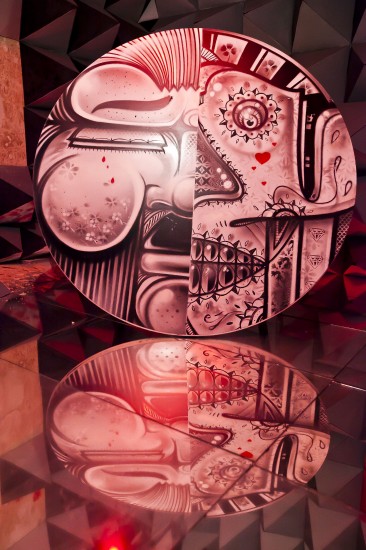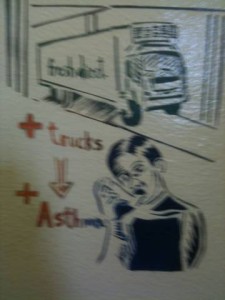
Works by 32 artists show borough’s many sides at Freedman House
Once known as the “home for poor millionaires,” an elegant mansion on the Grand Concourse has burst to glittering life as the home of a new art exhibit featuring 32 artists whose work meditates on the Bronx’s past and future.
Connoisseurs and artists mixed with hundreds of ordinary Bronxites at the April 4 packed-house opening of “No Longer Empty/This Side of Paradise,” which will run through June 5. Work, transportation, immigration, aging and the tension between reality and fantasy are some of the exhibit’s driving themes, all with local flavor as the common denominator.
“Art is about the community it is serving, and it’s very much a celebration of the Bronx’s culture,” said Manon Slome, the exhibition’s chief curator.
The show re-imagines the public rooms and bedrooms of the Andrew Freedman Home, built in 1924 as a haven for rich people who had lost their fortunes. Artists use broken glass and falling plaster, along with images of the burnt-out Bronx to symbolize the destructive years, and use cast-offs, including silverware and crockery, along with murals, videos, paintings, sculpture and photographs to create images of hope.
In a bedroom taken over by The Point Community Development Corporation, a video of “Village of murals,” the mural-lined route leading from residential Hunts Point to the South Bronx Greenway, plays on walls stenciled with flowers and foliage. As the video plays over the stenciled image of an African American girl, she appears to be walking down the industrial streets.

In “Trades/Oficios/Metiers,” undertaken in collaboration with The Point, French photographer Martine Fougeron uses photographs to underscore the city’s reliance on the industrial waterfront of Hunts Point and Port Morris. Her photographs are mounted on baking sheets to emphasize their connection with artisanal trades like baking and canvas stretching. They portray a worker in a recycling plant walking toward his crane, a fish handler slicing open a huge fish, a baker posing with one of her cakes.
“Through art I believe you can aim to bridge a knowledge gap,” Fougeron said. “Show what are inside the trades, how they work, to the residents—first by the photos, and I hope soon with a large scale installation of the photos outside the industries.”
The multi-media piece “IRT,” by Elizabeth Hamby and Hatuey Ramos-Fermin of Mott Haven examines transportation in the borough, with a spotlight on commuters and the workers who shuttle them from Point A to Point B.
“IRT” encompasses a video installation focusing on livery cabs, maps visitors can fill in with specific routes to see how to get around and interviews with passengers and the drivers and motormen who get them to where they’re going.
Other artists focused on the younger crowd.
The well-known sculptor John Ahearn collaborated with children from a Head Start program housed in the Andrew Freeman House to create plaster casts of their hands as a way of introducing the kids to their creative capabilities early on.
“From a very early age, it boosts their confidence and lets them know that they can,” said Marcia Fingal of the Mid-Bronx Senior Citizens council, which owns the Andrew Freedman Home.
Not only artists and connoisseurs were welcomed to take in the exhibition. Passers-by were encouraged to see the show, and many did so, joining the standing-room-only gathering.
“The lady said ‘Come, come in! Bring your girls! So I did,” said Maria Bibar, a mother of two. “We liked everything inside.”
Built to house elderly people who had been wealth but had lost their fortunes, the Andrew Freedman Home closed in 1983, and has since served as a community center. Across the Grand Concourse from the Bronx Museum of the Arts, it is now being recast as an arts and cultural space, and will also include a Bed and Breakfast.
“We want an inclusive and interactive relationship with the community,” said Fingal. “We want to make art and culture more inviting.”
The “This Side of Paradise” exhibit is open to the public Thursdays through Sundays between 1 and 7 p.m. For more information on Andrew Freeman House events, visit www.nolongerempty.org.


[…] last project the group ran in the area, “This Side of Paradise,” was held in the Andrew Freedman Home on the Grand Concourse in 2012. Its projects are intended to […]